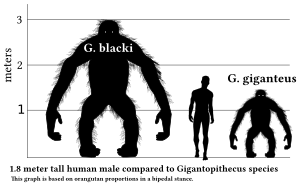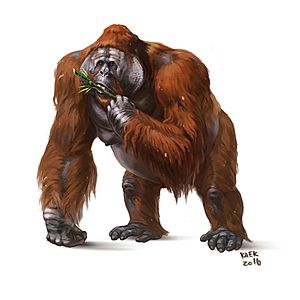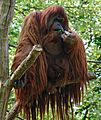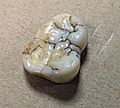Gigantopithecus facts for kids
Quick facts for kids GigantopithecusTemporal range: Pleistocene
|
|
|---|---|
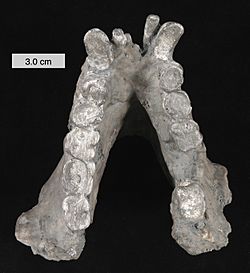 |
|
| Scientific classification | |
| Kingdom: | |
| Phylum: | |
| Class: | |
| Order: | |
| Family: | |
| Subfamily: | |
| Genus: |
†Gigantopithecus
|
Gigantopithecus was the biggest primate (a group of mammals that includes monkeys, apes, and humans) that ever lived. It roamed the Earth during the Pleistocene Era, which was from 1.8 million to 10,000 years ago. This was a time when many other huge mammals also lived.
Scientists believe Gigantopithecus lived in areas that are now China and Southeast Asia. Imagine an ape that could stand 10 feet tall on its hind legs! It probably weighed around 1200 pounds. To give you an idea, the largest gorilla today stands only about 6 feet tall and weighs between 300 and 400 pounds.
Contents
What Did Gigantopithecus Look Like?
We don't know exactly how Gigantopithecus moved around. This is because scientists haven't found any hip or leg bones yet. Most experts think it walked on all four limbs, just like modern gorillas and chimpanzees do.
However, a few scientists believe it might have walked on two legs, like humans. This idea came from studying the few jawbones that have been found. These jawbones are U-shaped and wide at the back. This shape would have allowed the windpipe to be inside the jaw. This means the skull could sit straight on an upright spine, similar to how humans stand.
Most scientists disagree with the two-legged idea. They think that walking on two legs would put too much stress on the legs, ankles, and feet of such a heavy animal. If it walked on all four limbs, like gorillas, its huge weight would be spread out better.
Based on the bones found, adult male Gigantopithecus blacki are thought to have been about 3 meters (10 feet) tall. They might have weighed between 540 and 600 kilograms (1,200 to 1,300 pounds). The very largest males could have even reached 900 kilograms (2,000 pounds)! This would make them three to four times heavier than modern gorillas. They would also be seven to eight times heavier than the orangutan, which is its closest living relative.
Large male Gigantopithecus might have had an arm span of over 3.6 meters (12 feet). There was a big difference in size between males and females. Adult females were likely about half the weight of males. Some scientists think that male Gigantopithecus blacki were actually smaller. They suggest males were about 1.8 to 2 meters (6 to 6.5 feet) tall and weighed 180 to 300 kilograms (400 to 660 pounds). This is because the size of teeth doesn't always perfectly match body size across different ape species.
We don't know exactly what Gigantopithecus looked like because we only have a few bone pieces. It might have looked like modern gorillas, since they might have lived in similar ways. However, some scientists think it looked more like its closest living relative, the orangutan.
If Gigantopithecus was as big as the upper estimates suggest, it probably had very few enemies when it was fully grown. However, younger, weaker, or injured ones might have been hunted. Predators could have included big cats, large snakes, crocodiles, saber-toothed cats, hyenas, and early humans like Homo erectus. If it was smaller, as the lower estimates suggest, even fully grown Gigantopithecus might have been hunted by all these animals, except maybe large snakes.
Where and How Did It Live?
This giant ape lived in Asia. It probably lived in bamboo forests. This is because its bones are often found near the bones of ancient relatives of the giant panda. Most evidence suggests that Gigantopithecus was a herbivore, meaning it ate only plants.
What Did Gigantopithecus Eat?
The jaws of Gigantopithecus were very deep and thick. Its back teeth (called molars) were flat and had thick enamel. This made them perfect for grinding tough, fibrous food. The teeth in front of the molars (called premolars) were also broad and flat, similar to the molars. Its pointed teeth (canines) were not sharp, and its front teeth (incisors) were small and peg-like.
All these tooth features suggest that Gigantopithecus was made for chewing very tough, plant-based foods. It could cut, crush, and grind its meals. Scientists have also found many cavities in Gigantopithecus teeth. This is similar to what is seen in giant pandas. Giant pandas eat a lot of bamboo, which suggests Gigantopithecus might have eaten a lot of bamboo too.
Besides bamboo, Gigantopithecus also ate other plants. Tiny plant remains found on its teeth confirm this. These tiny scratches and plant bits on its teeth suggest it ate seeds and fruit, along with bamboo.
Why Did Gigantopithecus Disappear?
Gigantopithecus likely died out about 100,000 years ago. During the Pleistocene era, the climate changed. The forests where it lived started to turn into savannas (grasslands). This meant that the amount of fruit, which was a big part of its diet, decreased. Gigantopithecus did not eat the grass, roots, and leaves that became common food sources in the new savanna environment. This change in food supply probably led to its extinction.
Images for kids
-
Gigantopithecus is closely related to orangutans (a male Bornean orangutan shown here).
See also
 In Spanish: Gigantopithecus blacki para niños
In Spanish: Gigantopithecus blacki para niños



